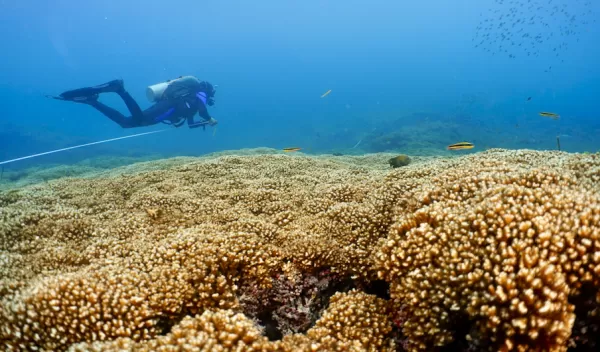
Coral reefs in the tropical Pacific could survive into the 2060s, study finds
Scientists at the University of Miami have found that some reefs in the tropical Pacific Ocean could maintain coral cover into the second half of this century by shuffling the symbiotic algae they host. The findings offer a ray of hope in an often-dire picture of the future of coral reefs worldwide.
While global warming is causing the loss of coral reefs globally, scientists believe that certain corals increase their tolerance to heat when the symbiotic algae communities they host change.
Shallow coral reefs in the eastern tropical Pacific Ocean are predominantly built by branching corals in the genus Pocillopora — sometimes known as cauliflower coral. The microscopic algae these corals host in their tissues harvest light to help the coral produce energy to grow. The loss of these symbiotic algae causes the coral to turn white, or bleach.
To better understand how corals improved their tolerance to heat stress, the researchers examined more than 40 years of coral reef-monitoring data from Panama, one of the longest datasets of its kind in the world. They analyzed temperature, coral cover, bleaching and mortality data spanning three ocean heatwaves (1982–1983, 1997–1998, and 2015–2016) along with data on algal symbiont community data.
The U.S. National Science Foundation-supported study was published in the journal PNAS. The study's analysis showed that the 1982-83 heatwave significantly reduced coral cover on the reef, but the effects of the 1997-98 and 2015-16 El Niño were milder, especially for corals in the genus Pocillopora.
The study also confirmed that during strong ocean heatwaves, the heat-tolerant alga Durusdinium glynnii becomes increasingly common in this lineage of corals, allowing them to better withstand periods of elevated temperatures.
When combined with climate projections of future heat stress, the reefs that were composed of Pocillopora corals and hosted this heat-tolerant alga were better equipped to survive and maintain high levels of coral into the second half of the current century.
"This study shows that there are unusual reefs that may be able to survive for several decades as a result of their ability to shuffle symbionts," said Andrew Baker, senior author of the study. "While we don’t think that most reefs will be able to survive this way, it does suggest that vestiges of our current reefs may persist for longer than we thought, although potentially with fewer species."


